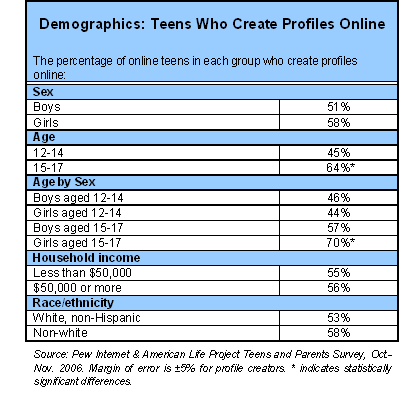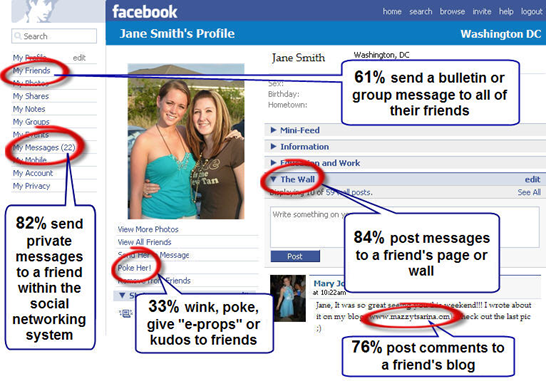More than half of online teens use social networks.
More than half or 55% of all online American teens use social networks.%%FOOTNOTE%% Likewise, 55% of online teens 12-17 have posted a profile online. Teen girls, particularly girls 15-17, are more likely to use social networking websites than boys, and girls are more likely to have posted a profile online.

Online social networks are spaces on the internet where users can create a profile and connect that profile to others to create a personal network. Social network users post content to their profiles and use tools embedded with in the social networking websites to contact other users.
Age is a particularly important factor for understanding teen use of social networks. For 12 and 13 year olds, social network use is not as prevalent, with just two in five (41%) of teens those ages using the sites. Once teens approach or enter high school, their use jumps — 61% of teens 14-17 use online social networks.
MySpace dominates the social networking realm, with more than 85% of teens with online profiles saying that the profile they use or update the most resides on that site. Following on its heels is Facebook, with 7% of profile-owners updating their Facebook profile most regularly. Another 1% have a profile on Xanga and others told us that they have a presence on sites like Yahoo, Piczo, Gaiaonline and Tagged.com, among others.%%FOOTNOTE%%
Teens who use social networking websites visit them frequently, both to edit their own profiles and to view the profiles of others. Almost half of teens who use social networks, visit them once a day (26%) or several times a day (22%). One in six (17%) visit the sites 3 to 5 days a week and 15% visit them 1 to 2 days a week. One in five or 20% say they visit online social networks every few weeks or less often.
Teens use social networks from the places where they go online most often. For most teens, that means that they use social networks on their home computers. Teens who go online from home are more likely to visit social networking websites and have a profile posted online than their counterparts who go online most often from school.
Parents usually know if their teen has a profile online.
Most parents of online teens are aware that their children have profiles on the internet. Nearly half (49%) of parents of online teens say that their child has a profile online, and 45% say that their child does not have a profile online. Six percent of parents say they do not know whether the child has a profile online or not. Parents of girls and older teens are much more likely to (and quite accurately) say that their child has a profile online. Some 57% of parents of girls say they have an online profile compared with 40% of parents of boys; 58% of parents of older teens say their child has a profile, compared with 39% of parents of teens 12-14. Parents of older girls are the most likely to report that their teen has an online profile – 67% of parents of girls 15-17 said that their daughter had a profile online.
Of parents of teens with online profiles, three-quarters (73%) accurately stated that their child had a profile online, while 23% incorrectly said that their child did not have an online profile. Another 4% of parents of teens with online profiles reported that they were not sure if their child had one or not.
Social networks provide public and private communication tools.
Social networking websites offer a variety of ways for users to communicate with people both in and out of their personal social network. There are private messages that can be sent from user to user, but there are also more public means of communicating within the social networking space. A user can post messages to a friend’s page or wall, send a bulletin or group message to a user’s network, post comments to a friend’s blog, or give e-props, “pokes” or kudos by posting small icons to a friend’s page. An early high school-aged boy explained how it works in our focus group: “People send friend requests so you can approve or deny it and you can ask to be someone’s friend, so once you approve them you can post comments about them and receive comments from them, but if you’re not friends with someone they can still give you messages.”
The most popular way of communicating via social networking sites is to post a message or comment to a friend’s profile, page or “wall.” More than 4 in 5 social network users (84%) have posted messages to a friend’s profile or page. “It’s a nice feeling to get, like, comments,” said an early high school-aged boy.

Social networks provide affirmation and feedback for teens.
One of the major reasons why teens are such enthusiastic users of social network sites is that the sites give them opportunities to present themselves to a group of peers and then get feedback and affirmation via the content tools built into the online social networking system. Teens get to feel like they are a part of a group of like-minded friends, and can visualize their network of relationships, displaying their popularity for others. This sentiment was expressed repeatedly in our in-person focus groups as well as in online forums where teens discussed the appeal of social networking sites.
Here are some of the most illustrative comments:
“Part of what people like about it is when you go on and you do your profile and there’s this little box at the bottom that tells you if you have a new friend request or new comments and so you click on it and then you see what’s going on.” – Boy, Early High School
“If you wait more days then they accumulate more.” – Boy, Early High School
“It is a great feeling. Like if you go on there and you haven’t been on in a day and you don’t find anything in the box, you don’t want to be on there anymore but if you go on there and there’s a new picture, comments, people want to talk to you, you start feeling part of a group.” — Boy, Early High School
“And you feel special when you have a picture comment.” – Girl, Middle School
“It’s a sense of attention. For some people it’s like ‘well, people know I exist, I’m there, people acknowledge me,’ you know you feel like you’re a part of something.” – Boy, Early High School
“It’s like there’s a sense of like you can put your interests and stuff on there and people can be like ‘well, yes I like that too’ and stuff and you can start talking to someone and eventually it’s like you get friends from it. Like you start meeting more people that have the same interests and you’re part of a group now.” – Boy, Early High School.
[ways to]
“I go on MySpace. I have my own. I do it to comment on people and look at other people’s MySpace. You get to know their personality by their MySpace. It says a lot about them just like how they decorate it and the pictures.” – Girl, Early High School




